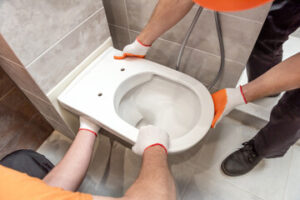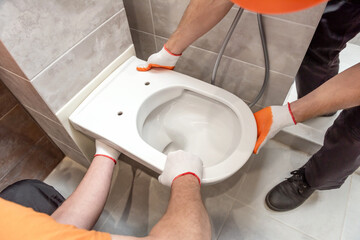When it comes time to upgrade your bathroom, a new toilet is one of the most important components you can add. There are a variety of styles, colors and options to suit your personal tastes and lifestyle.
Toilet installation is a complex process that requires plumbers and framers to consider the location of the toilet as well as other features, such as wall paneling, shower doors and baseboards. This is particularly true if the toilet is being moved or replaced with a model that is different in size or shape.
If you are installing a floor-mounted toilet, the standard rough-in distance is 12 inches from a finished wall. This allows you to easily interchange a new toilet with an old one, and it ensures the water tank is located far enough from the back wall that the toilet can be installed flush against the wall.
You should also measure the distance from the toilet flange to any sidewall or other nearby fixture. A bare minimum of 15″ is required, but this can be expanded to 24″ or more if you live in a jurisdiction that adheres to the International Plumbing Code (IPC).
Generally speaking, a toilet needs to be located at least 5 feet from the vent stack or main drain so that it will be able to pass sewage. This is because toilet drainage pipes are gravity-fed and must drop at a vertical rate of 1/4 inch for every horizontal foot, which can limit their ability to travel across the joists between parallel rafters.
In many cases, you may need to install a sanitary tee to connect the toilet drain to the existing drainage branch or stack. The tee can be cut into the existing pipe and will help prevent the toilet from blocking the drain.
Assuming that you are not planning to move the main drain, you can use a sewage ejector pump to transport waste from your toilet to the main drain. This will save you from moving the drain to accommodate your new toilet.
The ejector pump is powered by electricity, and it will pump waste into the main drain at a rate of up to 2 cubic feet per minute, depending on the model. However, you should not expect this to be a permanent solution because you will need to replace it every few years or so.
The toilet tank is the storage area for water used during a flush. It’s also a place where waste can collect and be disposed of properly.
The tank holds enough water to refill the bowl after each flush, but not so much that it causes excess water to spill over onto the floor. That’s why it has an overflow tube that keeps the water level from rising above the top rim of the tank.
Inside the tank are several key components that make the entire operation run smoothly. These include the float, the fill valve, and the flapper valve.
Float: The float on the end of a rod or arm controls the fill valve by raising or falling with the tank’s water level. It shuts off the flow of water in the tank when it reaches a certain height.
Some floats have an adjustable screw on the end that allows you to set the level. It may not always be easy to access, so it’s best to call a plumber if you think the float needs to be adjusted.
Fill Valve: The fill valve regulates the amount of water that goes into the tank and sends it to the bowl at the same time. It’s usually an adjustable type that can save you money on your water bill.
Flush or Trip Lever Arm: This metal or plastic extension connects to the flush or trip lever and extends up from the handle or over the top of the flapper. When adjusted correctly, it connects to the flush or trip lever chain/tail and pulls the flapper open during a flush.

